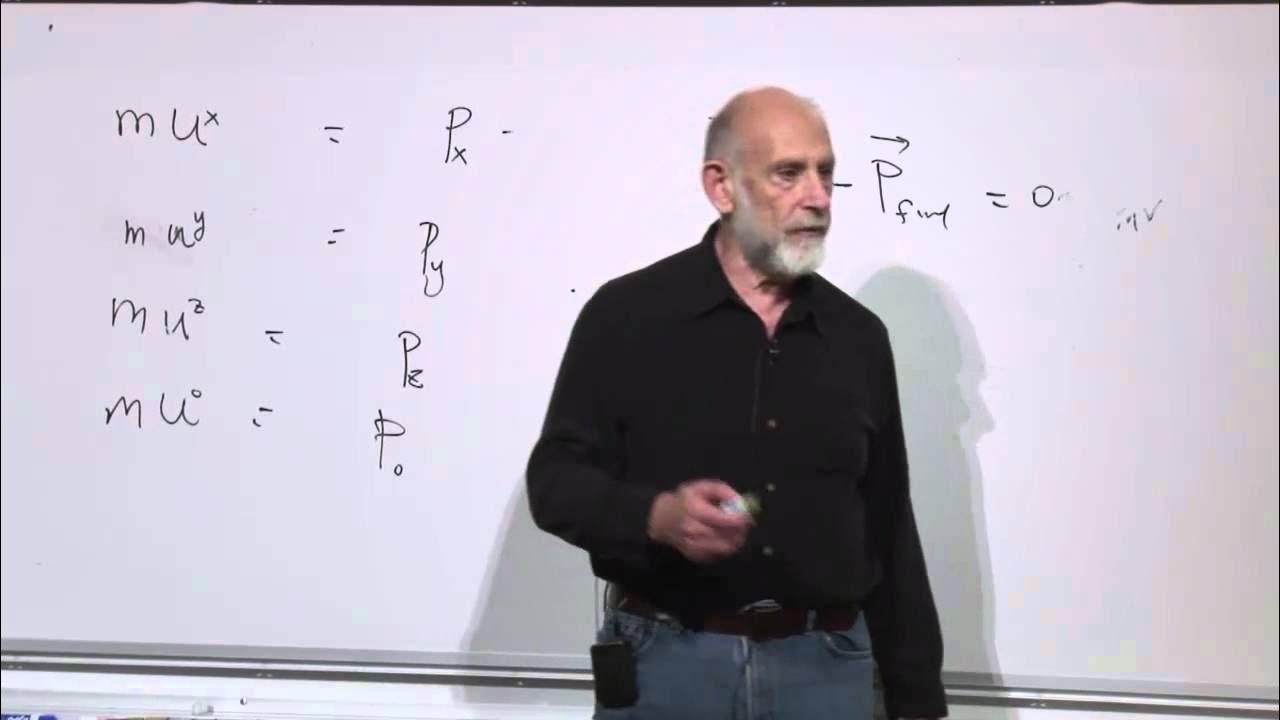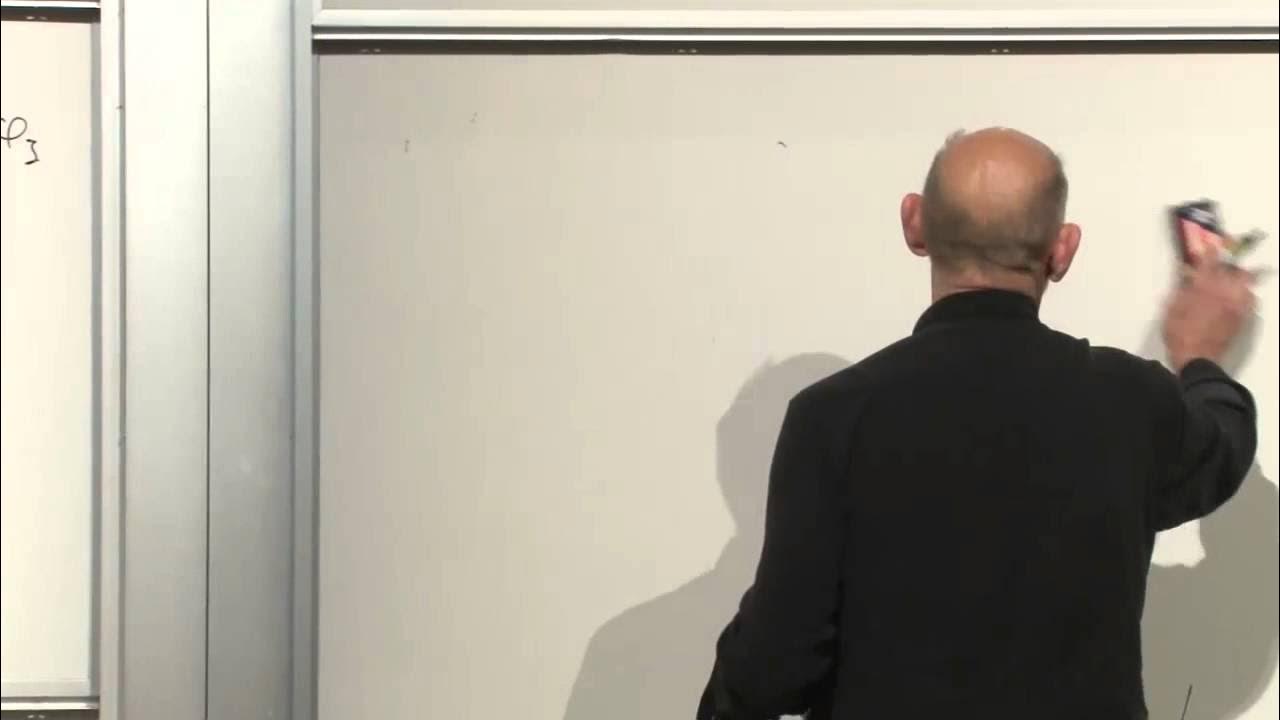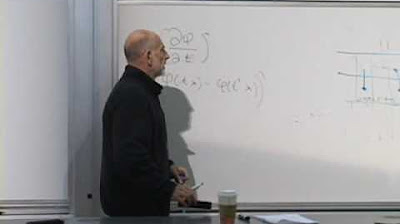Classical Mechanics | Lecture 3
TLDRThe provided transcript is a detailed lecture on the principle of least action, a fundamental concept in classical physics. The lecturer begins by clarifying the principle's name, emphasizing that it refers to 'stationary' rather than 'least' action, meaning that the action's value remains constant under small changes in the system's trajectory. The concept is explored through various contexts, such as equilibrium states, potential energy, and the forces acting on a system. The lecture then delves into the mathematical framework of the principle, connecting it to the calculus of variations and illustrating how it can be applied to find trajectories that minimize a certain quantity, known as action. Several examples are given, including the shortest path between two points on a flat or curved surface, the path of light rays, and the motion of particles in different coordinate systems. The lecturer also discusses the Lagrangian and Hamiltonian formulations of mechanics, highlighting their utility in different coordinate systems and their role in deriving equations of motion. The conservation of energy and angular momentum are also touched upon, with the lecturer pointing out that the Lagrangian formulation does not always present energy in a straightforward manner. The lecture concludes with a discussion on the general applicability of the Lagrangian framework to all known physical phenomena and its significance in the broader context of physics.
Takeaways
- 📐 The principle of least action is a fundamental concept in physics, often misinterpreted as 'least' but correctly 'stationary', meaning the action does not change with small perturbations in the path taken.
- 🔧 The Lagrangian (L) is a function that packages the kinetic and potential energy of a system and is used to derive the equations of motion using the principle of least action.
- 📈 Action in physics is analogous to the concept of distance in geometry; it's an integral over a trajectory and is used to find the path that makes this integral stationary.
- 🛠️ The Euler-Lagrange equations are derived from the principle of least action and provide a set of differential equations that govern the motion of a system.
- 🧮 The Lagrangian formalism is particularly useful for changing coordinates, making it easier to express the laws of physics in different coordinate systems.
- ⚖️ When the Lagrangian does not depend on a certain coordinate, there is a conserved quantity associated with that coordinate, which is a consequence of Noether's theorem.
- 🌀 In a rotating frame of reference, fictitious forces such as the centrifugal and Coriolis forces appear, which are not present in an inertial frame.
- ⏱️ Time is often considered to flow upward in diagrams, which is a convention based on cognitive studies showing that left-to-right readers mentally progress time from left to right and upward.
- 🔄 The conservation of angular momentum is a direct result of the Lagrangian not containing the angular coordinate in a central force problem, assuming no explicit dependence on the angle.
- 📉 The principle of least action can be applied to various physical scenarios, including finding the shortest path (geodesic) on a curved surface or the path of light that minimizes travel time.
- 🧘♂️ The action principle is a powerful tool in physics, providing a unified framework for formulating the laws of motion and conservation laws across different physical systems.
Q & A
What is the Principle of Least Action?
-The Principle of Least Action is a fundamental principle in physics that states that the path taken by a system between two points is the one for which the action is stationary (i.e., it minimizes or maximizes the action). It is not necessarily the path of least action, but rather the path of least change, which can also involve paths of greater action under certain conditions.
What does it mean for a system to be in equilibrium?
-A system is in equilibrium when there are no reasons to think the object moves. This means that the forces acting on the system are equal to zero, and there is no acceleration. In terms of potential energy, equilibrium occurs when the derivative of the potential energy with respect to the system's configuration is zero.
What is the role of the Lagrangian in formulating the equations of motion?
-The Lagrangian, denoted as L, is a function that combines the kinetic energy and potential energy of a system. It is used to derive the equations of motion for the system via the Euler-Lagrange equations. By minimizing the action, which is the integral of the Lagrangian over time, one can obtain the equations that describe the system's motion.
How does the Lagrangian differ from the Hamiltonian in classical mechanics?
-While both the Lagrangian and Hamiltonian are used to describe the dynamics of a system, they represent different aspects of the system's behavior. The Lagrangian is a function of the coordinates and their time derivatives (velocities), and it leads to the Euler-Lagrange equations. The Hamiltonian, on the other hand, is a function of the coordinates and their canonical momenta and is used in the Hamiltonian formulation of classical mechanics, which involves the Hamilton's equations.
What is the significance of the Euler-Lagrange equations in physics?
-The Euler-Lagrange equations are a set of differential equations that arise in the principle of least action. They provide a general method for finding the equations of motion for a system without explicitly solving for the action. These equations are essential in classical mechanics, as they can be applied to a wide range of problems to determine the trajectory of particles and the behavior of systems.
How does the principle of least action relate to the calculus of variations?
-The principle of least action is a specific application of the calculus of variations, which is a mathematical field that deals with optimizing functionals, i.e., functions of functions. In the context of physics, the functional of interest is the action, and the principle of least action states that the actual path taken by a system between two points makes this action stationary.
What are cyclic coordinates and why are they important in the Lagrangian formulation?
-Cyclic coordinates are those that do not appear explicitly in the Lagrangian. They are important because if a coordinate is cyclic, it implies the existence of a conserved quantity associated with that coordinate. This is a direct consequence of Noether's theorem, which relates symmetries in physical systems to conserved quantities.
Can the Lagrangian formulation be applied to systems with constraints?
-Yes, the Lagrangian formulation can handle systems with constraints. In such cases, one introduces Lagrange multipliers to incorporate the constraints into the Lagrangian, allowing the derivation of the equations of motion that respect these constraints.
What is the physical interpretation of the term 'dL/dv' in the Lagrangian formulation?
-The term 'dL/dv' (the derivative of the Lagrangian with respect to the velocity) represents the momentum of the system in the direction of the velocity. This relationship is useful for deriving the equations of motion and understanding the conservation laws associated with cyclic coordinates.
How does the Lagrangian formulation simplify the process of changing coordinates in a physical problem?
-The Lagrangian formulation simplifies the process of changing coordinates because the Euler-Lagrange equations take the same form in every coordinate system. This means that once the Lagrangian is known in one coordinate system, it can be expressed in another system without the need to re-derive the equations of motion from first principles.
What is the role of the potential energy in the Lagrangian formulation?
-In the Lagrangian formulation, the potential energy term contributes to the total energy of the system and influences the dynamics through the Lagrangian. It accounts for the forces that depend on the position of the system's particles, and its derivative with respect to position gives the force acting on the system.
Outlines
📚 Introduction to the Principle of Least Action
The video begins with an introduction to the principle of least action, emphasizing that it is often mistakenly referred to as the 'least' action when it actually pertains to a 'stationary' action. The lecturer clarifies that in classical physics, the principle is used to determine the path of least action that a system takes, rather than the path of least motion or least time. The concept is introduced within the context of equilibrium, where the forces acting on an object are zero, and the potential energy is stationary, not necessarily minimal.
🔍 Equilibrium and Potential Energy
The lecturer delves into the specifics of equilibrium, explaining that it does not require the potential energy to be at a minimum, but rather that the derivative of the potential energy with respect to displacement is zero. This indicates a state of balance where small displacements do not result in a change in potential energy, which is another way of expressing that the forces acting on the system are zero. The potential energy is described as stationary, and the讲师 (instructor) illustrates this with the example of a particle moving on a line, where the condition for equilibrium is the vanishing of the force derived from the potential energy.
📐 Multi-dimensional Equilibrium and Force Components
Building upon the concept of equilibrium, the video addresses scenarios with multiple coordinates, such as two-dimensional space. The讲师 (lecturer) explains that an object is in equilibrium when all components of force are zero, which translates to all partial derivatives of the potential energy with respect to each coordinate being zero. The讲师 (lecturer) further discusses how these conditions relate to various points on a potential energy landscape, including minima, maxima, and saddle points, which are all stationary points.
🔧 The Calculus of Variations and Action
The讲师 (lecturer) transitions into a discussion about the calculus of variations and the principle of stationary action, which is used to find trajectories that minimize a certain quantity, known as action. This principle is applied to various physical scenarios, such as finding the shortest distance between two points or the path that light takes between two points in a medium with a variable index of refraction. The讲师 (lecturer) provides mathematical formulations and explains the process of setting up and solving variational problems.
🌌 Action Principle in Classical Mechanics
The讲师 (lecturer) connects the principle of stationary action to classical mechanics, discussing how the action principle can be used to derive equations of motion for a particle. The讲师 (lecturer) introduces the concept of the Lagrangian, a function that encapsulates the kinetic energy minus the potential energy of a system, and shows how the Euler-Lagrange equations can be used to derive Newton's equations of motion. The讲师 (lecturer) emphasizes the power of the Lagrangian in packaging the laws of physics for a system and its utility in various coordinate systems.
🤔 Lagrangian and Conservation Laws
The讲师 (lecturer) explores the implications of the Lagrangian formulation, particularly the emergence of conservation laws when certain coordinates do not appear explicitly in the Lagrangian. These are referred to as cyclic coordinates, and their presence in a system leads to the conservation of a related quantity, such as angular momentum. The讲师 (lecturer) illustrates this with examples, including the case of a particle in a central force field, where the conservation of angular momentum simplifies the equations of motion.
🌟 Application of Lagrangian Mechanics
The video concludes with a discussion on the application of Lagrangian mechanics to various physical systems, including those with time-dependent or rotating coordinates. The讲师 (lecturer) demonstrates the process of transforming the Lagrangian into different coordinate systems and how this approach simplifies the derivation of equations of motion. The讲师 (lecturer) also touches upon the concept of energy in the context of the Lagrangian and hints at a deeper concept of energy known as the Hamiltonian, which will be covered in subsequent discussions.
Mindmap
Keywords
💡Principle of Least Action
💡Lagrangian
💡Equilibrium
💡Action
💡Euler-Lagrange Equations
💡Conservation Law
💡Coriolis Force
💡Fictitious Forces
💡Hamiltonian Formulation
💡General Relativity
💡Quantum Mechanics
Highlights
The principle of least action is introduced as a fundamental concept in physics, often misunderstood as 'least' but correctly 'stationary' action.
The concept of equilibrium in physics is explored, emphasizing that forces equal to zero is the condition for stationary states, not necessarily minimum potential energy.
The importance of the derivative of potential energy being zero at points of equilibrium is discussed, highlighting the significance of stationary points in potential energy landscapes.
The potential energy is described as stationary at equilibrium points, which is a broader condition than being a minimum, allowing for saddle points as well.
The change in potential energy (ΔV) with small displacements (ΔX) is used to define the condition for equilibrium, which is when ΔV equals zero.
The principle of stationary action is extended to trajectories and functions in space-time, linking to the famous calculus of variations problem.
The shortest line between two points is derived as a problem in the calculus of variations, emphasizing the principle of least action in the context of distance.
The principle of least time is introduced, illustrating how light rays follow paths that minimize travel time, not necessarily shortest distance, especially in variable media.
The Lagrangian formalism is presented as a powerful tool for deriving equations of motion from a single function that encapsulates the system's dynamics.
The Euler-Lagrange equations are derived, providing a systematic way to obtain equations of motion from a given Lagrangian.
The Lagrangian for a particle moving in a potential field is constructed, and it is shown how the Euler-Lagrange equations reduce to Newton's equations in this case.
The generalization to many particles and multiple coordinates is discussed, showing how the Lagrangian formalism handles complex systems elegantly.
The action principle is shown to be independent of the coordinate system used, making it a versatile tool for physics in various reference frames.
The Lagrangian for a particle in rotating coordinates is developed, revealing the appearance of fictitious forces like the centrifugal and Coriolis forces.
The conservation of angular momentum is derived from the Lagrangian formalism when the potential energy is independent of a coordinate, such as angle in polar coordinates.
The concept of cyclic coordinates is introduced, explaining why their corresponding momenta are conserved if the Lagrangian does not explicitly depend on them.
The Lagrangian formulation is contrasted with the Hamiltonian formulation, with a promise to explore the latter's deeper concept of energy in future discussions.
The transcript concludes with a reflection on the universality of the Lagrangian framework in classical physics and its foundational role in quantum mechanics.
Transcripts
5.0 / 5 (0 votes)
Thanks for rating:





